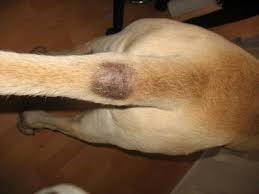Stud tail in dogs is a relatively common but often overlooked skin condition, particularly in unneutered males. It occurs due to overactive sebaceous glands near the base of the tail, leading to greasy fur, hair loss, irritation, and sometimes infection. If left untreated, stud tail can become uncomfortable for your dog and may develop into a more serious dermatological issue.
This guide will cover how to treat stud tail, its causes, symptoms, and the best preventive measures to maintain your dog’s coat health.
What is Stud Tail in Dogs?

Stud tail, also known as tail gland hyperplasia, is a skin disorder caused by excess oil production from the sebaceous glands located at the base of a dog’s tail. These glands secrete sebum, a natural oil that helps protect the skin and coat. In some dogs, however, the glands become overactive, leading to an accumulation of oil, waxy build-up, and even secondary bacterial infections.
This condition is most common in unneutered male dogs, as testosterone plays a role in stimulating these glands. Neutered males and even female dogs can also develop greasy tail syndrome, particularly under certain conditions.
Symptoms of Stud Tail
Recognizing stud tail early can help prevent complications such as infections. Common symptoms include:
✔️ Oily, greasy patch at the base of the tail
✔️ Hair thinning or bald spots around the tail gland
✔️ Waxy or crusty build-up on the skin
✔️ Unpleasant odour due to oil accumulation
✔️ Redness or swelling, indicating possible infection
✔️ Licking or biting at the tail due to irritation
If the condition worsens, bacteria may infect the area, leading to sebaceous tail disorder, which may require medical intervention.
Causes of Stud Tail in Dogs
Several factors contribute to the development of oily tail condition in dogs:
1. Hormonal Influence
Testosterone stimulates sebaceous glands, which is why stud tail is more common in intact (unneutered) males. Neutering often reduces symptoms, but it does not guarantee prevention.
2. Poor Hygiene and Grooming
Dogs that are not regularly groomed or bathed may develop excessive oil buildup, leading to tail gland hyperplasia.
3. Breed Predisposition
Certain breeds with thicker coats and higher oil production, such as Labrador Retrievers, Akitas, and German Shepherds, are more prone to sebaceous tail disorder.
4. Underlying Skin Conditions
Dogs with skin allergies, seborrhea, or folliculitis may be more susceptible to greasy tail syndrome.
5. Diet and Nutrition
A diet high in processed foods and unhealthy fats can contribute to excessive oil production, leading to stud tail.
How to Treat Stud Tail in Dogs
The treatment of stud tail depends on its severity. In mild cases, simple hygiene measures can resolve the issue, while more severe cases may require veterinary intervention.
1. Regular Cleaning with Medicated Shampoo
A critical step in how to treat stud tail is keeping the affected area clean. Use antiseptic, degreasing, or medicated dog shampoos containing benzoyl peroxide or chlorhexidine to remove excess oils. Bathing the area 2-3 times a week can help prevent oil buildup.
💡 Recommended Products:
- Benzoyl Peroxide Shampoo – Helps break down oil and unclog pores.
- Chlorhexidine Shampoo – Prevents bacterial infections.
- Mild Oatmeal Shampoo – Soothes irritation and reduces inflammation.
2. Topical Treatments for Stud Tail
Applying the right topical solutions can reduce oiliness, kill bacteria, and prevent infections.
✔️ Antibacterial wipes – Use chlorhexidine or witch hazel wipes to cleanse the area daily.
✔️ Apple cider vinegar (diluted) – Has antimicrobial properties that help prevent infections.
✔️ Aloe vera gel – Soothes redness and promotes healing.
✔️ Over-the-counter antiseptic sprays – Reduce bacterial growth.
3. Dietary Adjustments
Improving your dog’s diet and nutrition can help control excess oil production.
🐾 Increase omega-3 fatty acids (found in salmon, flaxseeds, and fish oil supplements) to support skin health.
🐾 Avoid processed foods and artificial additives that can trigger skin conditions.
🐾 Feed a high-quality, balanced diet rich in vitamins A, E, and zinc to improve coat condition.
4. Regular Grooming and Maintenance
Consistent grooming helps prevent sebaceous tail disorder by keeping the fur clean and reducing oil buildup.
✅ Brush your dog’s coat regularly to remove excess oil and debris.
✅ Trim the fur around the tail gland to reduce oil accumulation.
✅ Use cornstarch or oil-absorbing powders on the tail to absorb excess grease.
5. Veterinary Treatment for Severe Cases
If stud tail persists or worsens, consult a veterinarian. They may recommend:
📌 Oral antibiotics – To treat bacterial infections.
📌 Prescription medicated shampoos – Stronger formulations for severe cases.
📌 Hormonal treatments – In rare cases, medications to regulate oil production.
📌 Neutering – Reduces testosterone levels, which can decrease oil production in some dogs.
Preventing Stud Tail in Dogs
Preventing stud tail is easier than treating it. Here are some preventive measures:
🐕 Bathe your dog regularly with a degreasing shampoo.
🐕 Maintain a clean environment to prevent bacterial build up.
🐕 Provide a healthy diet rich in essential fatty acids.
🐕 Monitor your dog’s tail area for early signs of oil build up.
🐕 Neuter your dog if appropriate to reduce sebaceous gland activity.
By following these steps, you can prevent and treat stud tail effectively, keeping your dog’s skin and coat in optimal condition.
Final Thoughts
Stud tail is a manageable condition that, with the right care, won’t cause long-term issues for your dog. Regular cleaning, grooming, and diet adjustments can significantly reduce symptoms and prevent recurrence. If your dog shows signs of infection or discomfort, it’s important to consult a veterinarian for professional treatment.
By staying proactive and following this guide, you can ensure your dog remains healthy, happy, and free from skin irritation.
